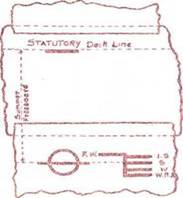Question
The ship side has a disc marked on it, make
a sketch of this and explain the meaning of the markings. What name is given to
the disc and why?
Answer.
The disc and other markings referred to, are called the Plimsoil mark,
after the name of the man who did so much in Parliament to have them made
compulsory in the Merchant Shipping Act. Before they were made compulsory,
shipmasters were allowed a great deal of freedom in loading a ship to what they
considered safe and no doubt the shipmaster considered the most competent was
he who carried the largest cargo and brought the ship safely to port. This led
to excessive loading, causing ships to founder at sea, with, in some cases,
great loss of life.

Fig. A.—Plimsoil mark.
"The large disc, Fig. A, has a line through its
centre marked S, which is the summer freeboard in sea water, W being the winter
time mark, and W.N.A. being winter, North Atlantic, I.S. is Indian summer, and
F.W. fresh water mark, which allows for the rise which takes place when the
ship goes to sea and the more buoyant sea water causes the ship to draw less
water. The F.W. mark is so many inches above S mark, but it must be understood
to refer to a distance above all the others for the various conditions of
loading.
It might be mentioned here that it is the duty of
every person who intends sailing on a ship to observe the Plimsoil
mark just immediately before sailing for if the ship is overloaded the
shipmaster can be reported and the ship detained until the loading is corrected
or the person can refuse to sail in the ship.
Freeboard (Fig. A) is the distance from the water load
line up to the main deck. The main deck is the highest deck that is
water sealed. Water falling on upper decks may run down companion ways, but it
cannot go any farther down into the ship than the main deck. When the ship is
in bad weather and ploughing her way through the
waves, she will at times displace a greater weight of water than her
own-weight, which will tend to push her up again. This extra weight of water
tending to push the ship up when in the above condition,
is represented by the freeboard. This extra volume of water
which the ship can displace in bad. weather and
is in reserve for that purpose, is measured by the water plane area multiplied
by the freeboard and is called the reserve buoyancy. Every ship must have
reserve buoyancy, as in case of heavy leakages into holds below the main deck,
or bilge pumps becoming defective or in case of collision, the hold would
gradually fill up with water. The reserve buoyancy, therefore, keeps the ship
from immediately sinking and allows time for repairs to be effected
and thus save the ship and incidentally the lives in the ship.